Student surveys are more than just checking a box. Whether the topic is bullying, classroom climate, or how students feel about virtual learning, surveys offer a direct line into the student experience. And while some students might crack jokes or dream up magical class schedules (no homework and pizza Fridays?), many take student surveys seriously when they’re thoughtfully created. That’s where SurveyLegend steps in — giving educators the tools to ask meaningful questions and gather valuable insights using a survey form to collect feedback on students’ classroom experiences. Student surveys can capture students’ classroom experiences, providing educators with actionable insights. Student surveys can be developed to address specific classroom needs, ensuring that feedback is relevant and actionable. SurveyLegend is an effective tool for educators to gather student feedback and improve teaching practices.
While it’s safe to assume surveying students of any age will bring about some of these frivolous requests, many students take a more thoughtful approach to surveys when they’re conducted appropriately and ask the right type of survey questions. Education surveys can provide insights into the school climate, including safety, relationships, and engagement. They can also help monitor and support student well-being as part of a holistic educational approach. Analyzing survey data can help educators improve student outcomes by informing strategies and interventions. Surveys foster a sense of ownership and belonging among students by giving them a voice in their education. The importance of student voices in shaping educational experiences and policies cannot be overstated. Student feedback can enhance teaching practices and the overall learning environment. This helps educators see what’s important in their students’ world so they can institute better plans and goals, administer funding, and more.
 Discounted Pricing for Educators & Students
Discounted Pricing for Educators & Students
Enjoy up to a 35% discount with our special pricing just for you!
Introduction to Student Surveys
Student surveys are a powerful way for educators to connect with their students and gain a deeper understanding of the classroom experience. By regularly gathering student feedback, teachers can identify what’s working well and where there’s room for improvement. Student surveys not only help educators collect valuable data but also engage students in the learning process, encouraging them to reflect on their own experiences and share their perspectives. This sense of involvement can foster a stronger sense of community and belonging in the classroom, making students feel heard and valued. When used thoughtfully, student surveys support teaching by highlighting areas for growth, guiding instructional decisions, and ultimately enhancing learning outcomes for everyone. Whether you’re looking to improve classroom climate, adjust your teaching strategies, or simply understand your students better, student surveys are an essential tool for educators committed to continuous improvement and student success.
The Importance of Student Surveys
Any educator can tell you that students are full of opinions, even if they don’t always want to hear them! But let’s look at some of the ways surveying students can become a powerful tool to help school administrators and educators collect valuable data. Student surveys can be used as a formative tool to guide instructional improvements and classroom strategies. Surveys can also collect feedback on individual lessons, helping educators identify which parts of the curriculum may be more challenging for students. Survey data also helps assess the effectiveness of teaching methods and school programs. Encouraging student participation in surveys is essential for collecting meaningful and representative feedback.
Revealing Problems or Trends
Educators are on the front lines when it comes to kids, but that doesn’t mean they always have insider information. Asking the right student survey questions can identify potential issues that administrators may be unaware of. They can then work to correct these issues before they become full-blown problems. Regularly analyzing survey feedback allows educators to monitor student progress over time. Educators can use survey results to reflect on their teaching practices and identify areas for improvement. Survey feedback also allows administrators to address specific classroom or school issues raised by students. Additionally, surveys encourage self-reflection among both teachers and students, promoting personal and professional growth.
Through surveys, many schools have been made aware of student challenges and have developed programs to support learners. Of course, students aren’t always forthcoming with this type of information. However, they may disclose it in an anonymous survey, which can push a school into action.
Revealing How to Make and Save Money
Funding in many school districts remains down, resulting in teacher layoffs, higher classroom density, cuts in the arts and sports programs, and outdated books and teaching materials. While students may not always have the answer to finding budgetary support, their survey responses can be used to apply for funding through grants.
Based on what students deem important, school officials can determine where critical resources and funding should be distributed. Schools benefit from using student survey data because it helps them make informed decisions that lead to more effective allocation of funds and resources. In addition, the data from survey results can give key decision-makers a clear picture of the school’s financial investments and goals.
Improving Reputation with Real Feedback
In today’s world of viral posts and online reviews, schools need to be proactive about their public image. Survey feedback from students can spotlight the strengths that are too often overlooked. It’s also an opportunity to address concerns before they spiral into bigger problems. When students rate their teachers, facilities, or the overall classroom environment, the school gains real-time insight that can support public relations and strategic communication. This feedback can directly contribute to the success of a school’s reputation and public image.
Crafting Effective Student Survey Questions
The quality of your student survey questions can make all the difference in the feedback you receive. To gather meaningful insights, it’s important to design questions that are clear, concise, and directly related to the learning experience. Consider using a mix of question types—such as multiple-choice, open-ended, and rating scales—to capture different aspects of student feedback. This variety allows students to express their opinions in multiple ways, providing a more complete picture of their experiences. Keep surveys focused and brief to maintain student engagement and avoid survey fatigue. Well-crafted student survey questions help teachers and educators collect actionable feedback, understand student attitudes, and identify opportunities for improvement. By thoughtfully designing your surveys, you can gain valuable insights that inform instruction, enhance learning, and support positive outcomes for all students.
10 Types of Student Surveys with Examples
Now, while we’ve been looking at the bigger picture of the benefits of student surveys, it’s also important to look at the basics, which can often serve to highlight some of these more pressing, larger issues. Surveys can be designed to measure different aspects of the educational experience, from academic performance to social and emotional well-being. Here are eight potential surveys that educators may want to consider, including examples with some student survey questions.
Student Surveys of Teachers
The purpose of student surveys of teachers is to give teachers ideas of how the class might be improved and to provide feedback on their performance. Instructors can access survey results to better understand student perceptions and improve their teaching. Providing instructors with easy access to survey dashboards and feedback tools supports ongoing professional development. These surveys can also give school leadership an idea of which teachers are engaging with their students and which may be falling short. In the simplified survey example below, we use stock photo imagery to ask students to describe their teacher; photos of the actual teachers could also be used.
Most students are highly visual, and zoomers prefer photos to words-only, making visual surveys the best way to engage with them. Read more about how easy it is to create great visual surveys and polls with pictures using SurveyLegend and the seven benefits of picture surveys.
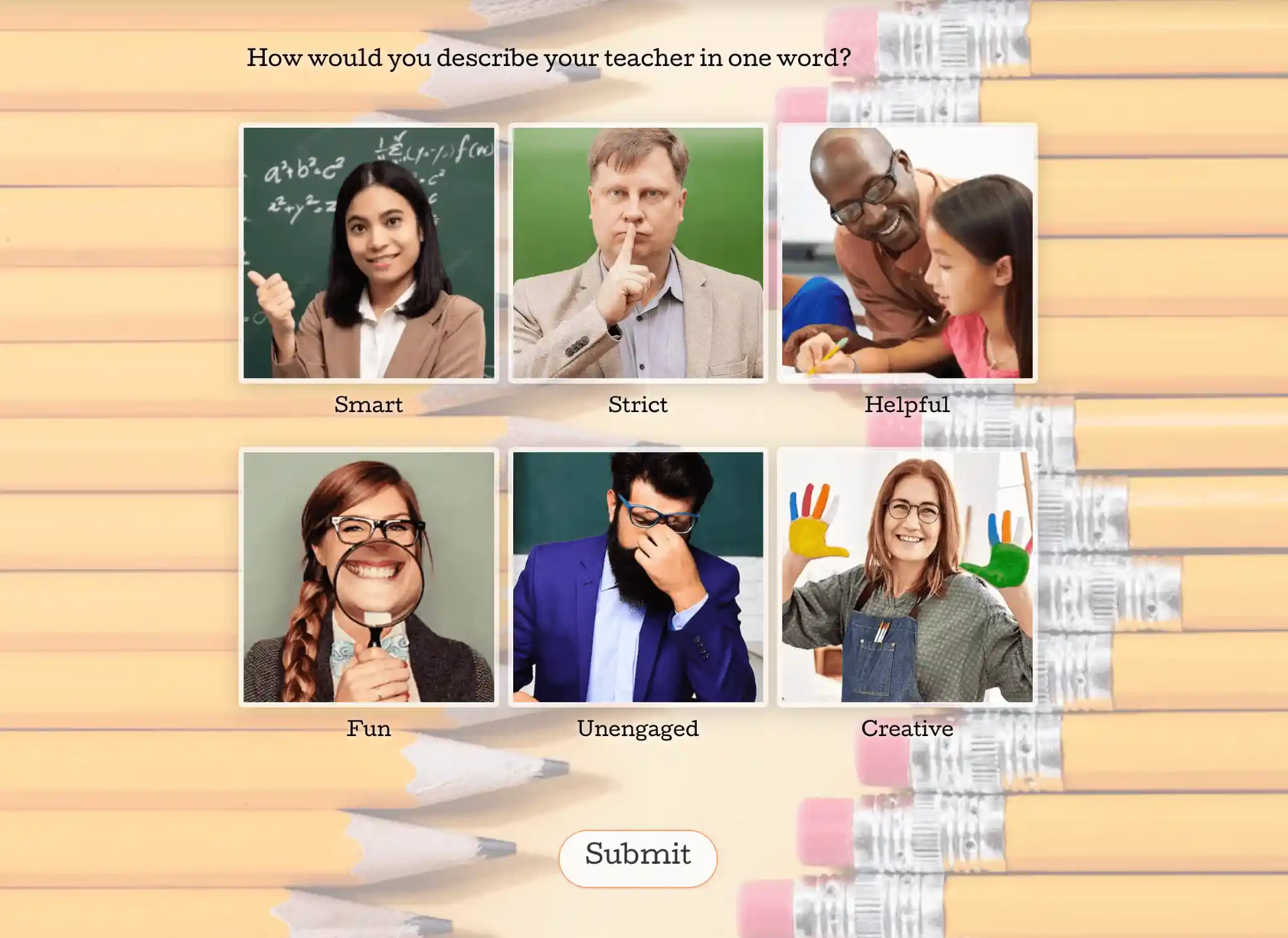
Student Feedback Survey
These generally apply to course assessments, regardless of student age. You can ask a kindergartener what they thought of their classwork (“just okay, but art was great!”) or a university student (“Economics 101 is useless for my future”). Either way, it provides open and honest feedback. Student feedback surveys can include questions about recent tests or assignments to gauge their difficulty and relevance. Encourage students to provide suggestions for improving the course or addressing challenges they faced. You may be tempted to think those answers are unhelpful; however, could you change the kindergartner’s future classes to be sure he or she gets more art education? Or, could you allow the college student schedule customization so they can focus more on what matters to their impending graduation plans? Ultimately, this type of survey can also give your input on what students think of their course facilitators in order to re-train them or give them a high-five.
In the example below, we used SurveyLegend’s Smile Ranking, which is perfect for students today who typically use emojis every day in their personal text messages and social media posts.
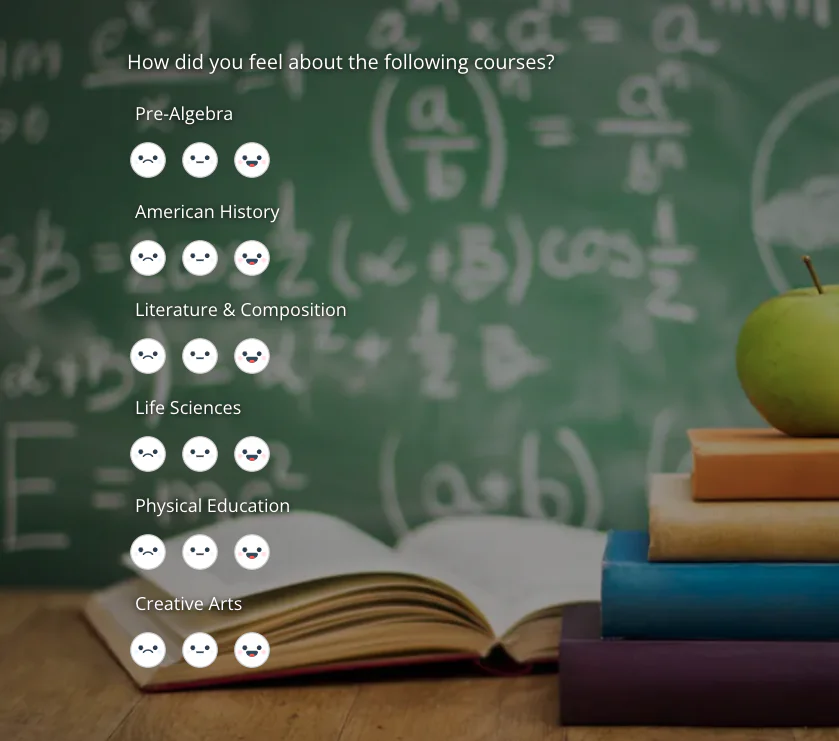
Student Satisfaction Survey
A student satisfaction survey asks students how they feel about a school’s environment and facilities. While the questions on this type of survey will vary, sometimes wildly, especially when considering the age of the students, it’s ultimately designed to assess educational, social, and other aspects of the school or university. Collecting high-quality responses is essential to ensure the survey data is accurate and actionable. You can see a template of a university student satisfaction survey here.
In the survey example below, we used a matrix survey that bundles questions under one main question. This makes the survey appear shorter (which typically means a higher response rate) and keeps it looking clean. Shorter surveys generally have higher completion rates. Learn more about SurveyLegend Matrix Questions.
NOTE: It’s easier to understand how our Matrix Survey works by seeing it in action. The example below is live, give it a try!
Student Engagement Survey
Student engagement surveys measure students at any level and are most common for university students. These surveys are specifically designed to engage students in the feedback process and encourage their active participation. They help higher learning institutions gain actionable data that enables them to improve teaching and learning. This unique approach is gaining momentum, as it provides insight into what is driving student knowledge and, perhaps more importantly, care. These surveys can help revise curricula, drawing in new students with relevant studies, and boosting enrollment. In the example below, we used SurveyLegend’s thumb ratings.
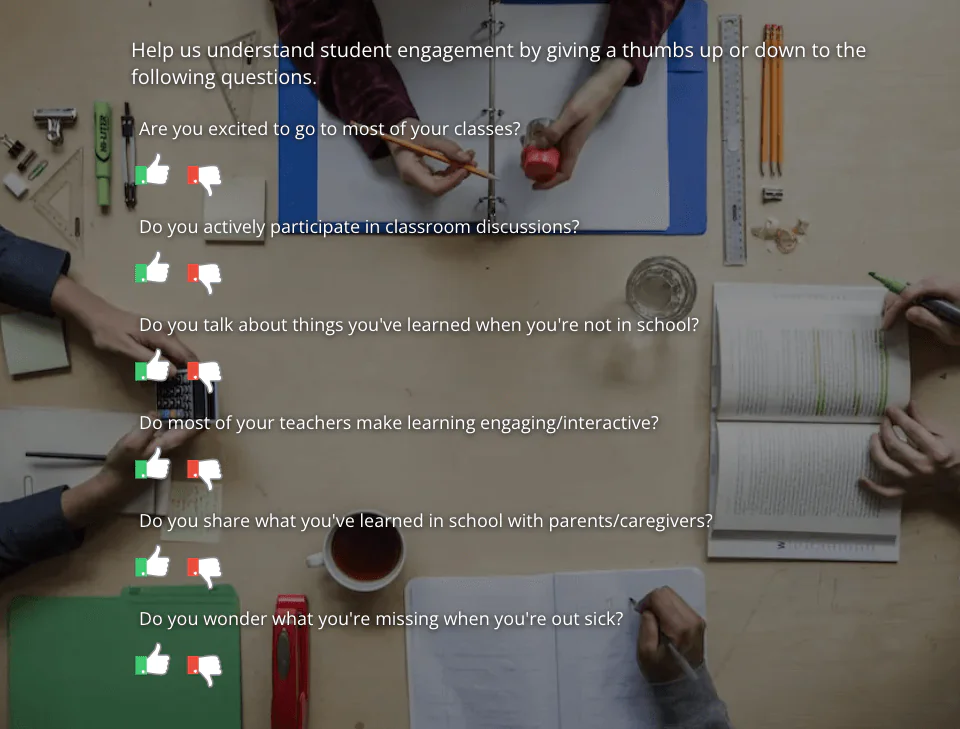
Student Graduation Survey
Sometimes, the best insight you can get into your school or university is through students who are saying goodbye for good, as they have nothing to lose by being honest (the same concept applies to companies that hold “exit interviews” for employees who are leaving). The graduation survey asks students to assess many aspects of their learning and social experience so that leaders can make changes as needed or build upon noted strengths. Graduation survey reports help school leaders identify trends and areas for improvement.
It’s important to remember, just as in exit interviews, that the freedom of leaving responses without repercussion may result in survey bias; however, if there are enough students noting the same challenges, it’s likely worth a deeper look. Check out our student graduation survey template here or learn more about SurveyLegend’s star ratings as seen in the example below.
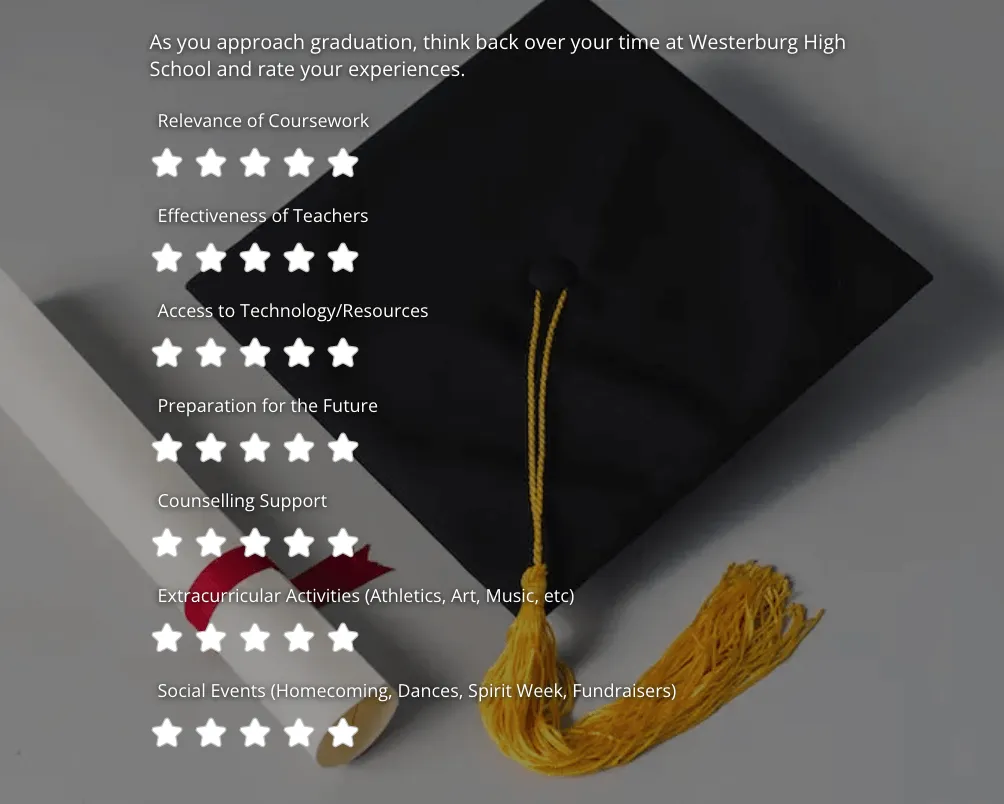
Student Motivation Survey
Usually used in K-12, this type of questionnaire explores motivational aspects of students to determine whether they rank low, moderate, or high in a number of categories, such as their need for achievement (how important are grades?) and their need for intimacy (how much do social connections matter?). Motivation surveys can also assess students’ academic goals and their drive to succeed in school. Answers to these questions can help educators customize their student curricula and experiences. In the example below, we used SurveyLegend’s Slider Ratings, which makes it interactive – a great way to keep students engaged with the survey.
NOTE: The slider survey below is live, so go ahead and try it out using the sliders!
Back to School Survey
This is an easy one. It’s designed simply to give every student a voice at the beginning of the school year, regardless of grade. Back-to-school surveys are often conducted upon students’ entry into a new grade or program to capture their initial thoughts and expectations. It could ask what the student looks forward to, or what they’re dreading! It exists to give educators a gauge of the incoming students’ thoughts, hopes, and fears for the year. That way, educators can improve upon the good and mitigate the bad.
Learn more about SurveyLegend’s Picture Rankings as seen in the survey below.
NOTE: Want to try out our Picture Ranking Survey? It’s live, give it a go below!
Open-Ended Student Survey
Open-ended questions can offer a lot of insight. They allow students to respond freely without having to select an answer from a list of options or choose some sort of rating. The purpose of using them on surveys is to probe deeper into a participant’s thoughts and feelings. Of course, this type of research is qualitative, not quantitative, which can make analysis more difficult. Often, student surveys will use a combination of quantitative and qualitative questions. In the example below, the first question asks students to rank their teachers by engagement level using a picture ranker, but then asks a follow-up open-ended question.
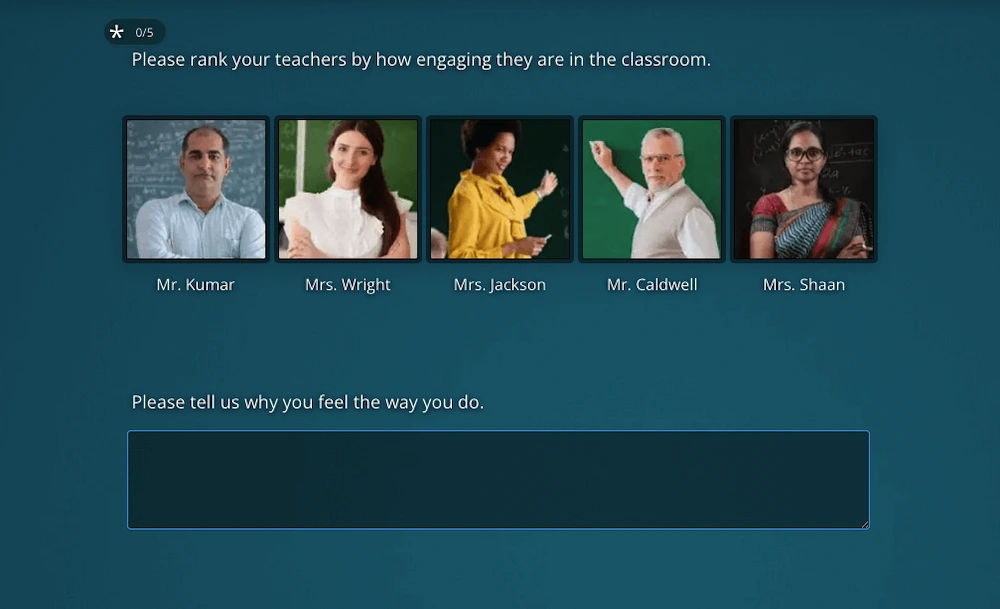
Virtual Learning and Pandemic Survey
Virtual learning is here to stay. Some school districts were already offering virtual or distance learning, but then the pandemic with the Coronavirus (and safety and bullying incidents) kicked it into high gear. Today, more than 20% of public schools and 13% of private schools in the United States offer online courses for students. Additionally, 2500 colleges offer online programs. To navigate this new virtual landscape, educators can use surveys to prepare themselves for classes, meet student expectations, teach, and assign work. Virtual learning surveys can be distributed and analyzed in multiple formats, such as online forms, PDFs, or spreadsheets, making it easier to collect and share data for evaluation and reporting. Be sure to check out our blogs 15 Student Survey Questions to Ask About COVID, for more!
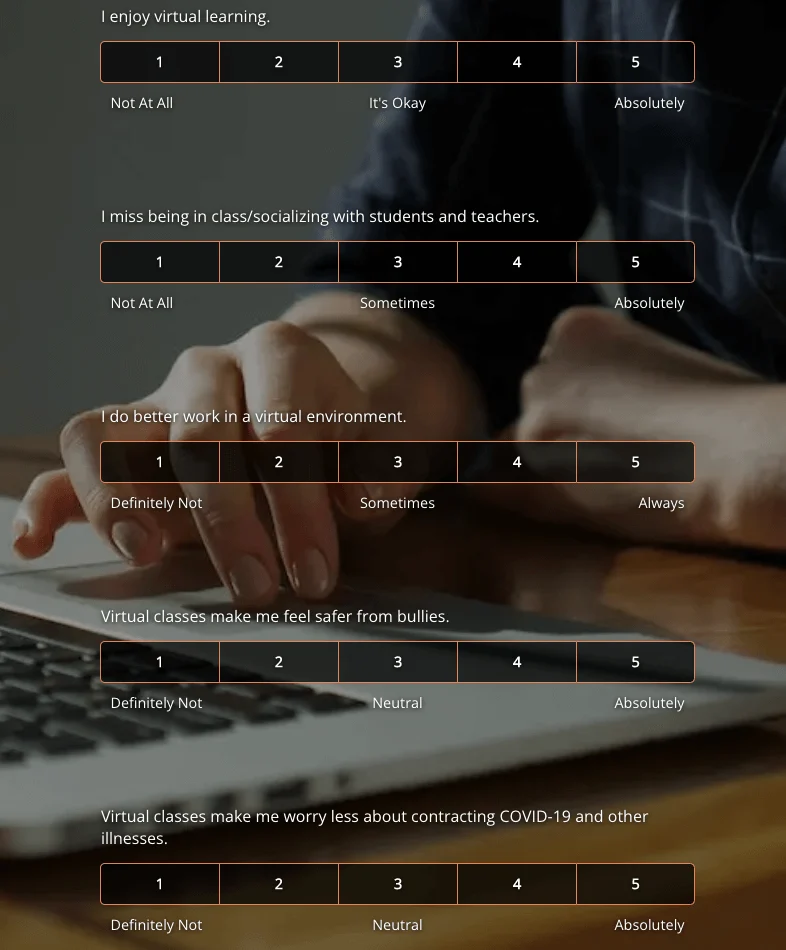
Individual Course Survey
Educators or administrators may choose to ask learners about an individual course. These surveys can be tailored to gather feedback on a particular subject or area of study. The best way to do this may be with a multiple-choice survey, as seen in the example below. You may also include open-ended questions to gain deeper insights, such as what students found most valuable or what could be improved.

Analyzing Survey Results
Once you’ve collected student feedback, the next step is to analyze survey results and to drive meaningful change. Start by looking for patterns and trends in the data—are there common themes in what students are saying about the school climate, teaching methods, or their overall well-being? Use these insights to identify strengths to build on and areas where students may need additional support. Survey results can inform instructional decisions, help evaluate the effectiveness of programs, and guide improvements in teaching strategies. By regularly reviewing and reflecting on survey data, educators and school leaders can enhance student engagement, promote a positive school environment, and support student well-being. Additionally, survey results provide valuable information for program evaluation, accreditation, and educational research, making them a key resource for continuous improvement in schools.
Improving Response Rates
Getting a high response rate is essential for making sure your student surveys truly reflect the voices of your students. To boost participation, make surveys accessible and easy to complete—offer them in multiple formats, such as online and paper-based options, and ensure they can be filled out anonymously to encourage honest feedback. Engaging survey designs and clear instructions can also help motivate students to participate. Consider offering incentives, like extra credit or public recognition, to further improve response rates. Timing matters too: administering surveys at the beginning, middle, or end of a course can capture feedback at different stages of the learning process. By focusing on accessibility, anonymity, and engagement, educators can gather more comprehensive student feedback, leading to better instruction, improved outcomes, and a stronger, more positive school climate.
Conclusion
The importance of student surveys can’t be discounted—however, we’re willing to give you a discount to do just that. Student surveys are used by schools and universities across the country to improve educational outcomes. At SurveyLegend, we know that as educators, you have a strict budget that you must meet. We also know you want to be aware of student needs and concerns. Collecting feedback, then, is a must, so we’re proud to offer a 35% discount on our yearly plans and also a first-time 15% discount on all our monthly plans for teachers and educators, schools, and universities.
Do you use surveys in your school district or at your university? What types of questions do you ask, and how has it benefited you? Sound off in the comments! Want to learn more about how generational differences impact surveys before creating your survey? Check out our blog 12 Things to Consider on Gen Z Surveys.
 Discounted Pricing for Educators & Students
Discounted Pricing for Educators & Students
Enjoy up to a 35% discount with our special pricing just for you!
Frequently Asked Questions (FAQs)
Why are student surveys important?
They can uncover many things, such as overall satisfaction with schooling, incidents of bullying, thoughts on virtual learning during COVID, and more. Surveys also help ensure that students feel heard and valued in their educational experience.
How can schools survey students?
In today’s digital world, an online survey is the best way to reach students of every age. Online surveys can also be made anonymous, giving students the ability to be completely honest with their responses. Both members and non-members of educational organizations can access survey tools and data. Companies like Panorama Education provide comprehensive survey instruments for schools. A well-designed survey instrument is essential for collecting reliable student feedback. Surveys can be used to gather feedback on specific projects or initiatives within the school. It is important to encourage students to complete their surveys to ensure their feedback is counted. Monitoring response rates is also crucial to improve survey participation and data quality.
When should I get feedback from students?
Surveys can be used year-round to gauge student response to anything. Additionally, surveys can be administered at the beginning, middle, or end of the school year to aid in planning effective classes.



